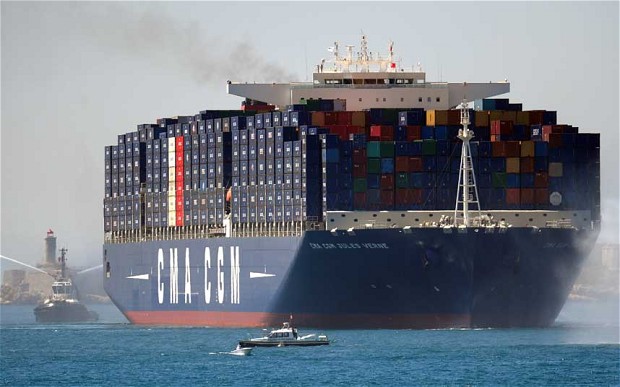Container shipping lines are turning more emphatically toward cutting costs and capacity as weak market conditions take a bigger toll on bottom lines.
Singapore-based Neptune Orient Lines Ltd. said in reporting a deeper third-quarter loss that the traditional surge in shipping heading into the fall never arrived and that carrier would focus on efforts to “drive cost and yield optimization.”
The statement followed the announcement by Maersk Line, the shipping unit of A.P. Moeller-Maersk A/S last week that it would idle one of its “Triple E” megaships for at least six weeks amid poor demand and falling freight rates.
NOL, the parent of APL—the world’s 12th largest container ship operator, according to Alphaliner—lost $96 million in the quarter ending Sept. 30, more than four times the $23 million loss the company showed in the same period a year ago.
At the same time, two of Japan’s big three shipping lines reported disappointing results and pointed to deteriorating demand.
Mitsui O.S.K. Lines Ltd., also known as MOL, reported profit nearly 16% below what the company had earlier forecast for the April-to-September period. Income at Kawasaki Kisen Kaisha Ltd., the Japanese liner known as “K” Line, was off 38% for the six months ending Sept. 30 from the same period last year.
Executives and analysts attributed the losses to industry wide overcapacity, which has hammered freight rates world-wide, as well as weaker demand in amid slowing exports out of China and weaker demand in Europe.
MOL, pointed to a global “mood” of slowdown. Declining exports from North America, largely attributed to the strength of the dollar and uncertainties in global markets, also drove volumes down. Like other shipping lines, MOL tried reducing the number of vessels to prop up rates and make the remaining services more profitable.
“K” Line, too, said it was cutting costs in various ways, including “rationalizing service capacity in line with market demand.”
Nippon Yusen Kabushiki Kaisha, known as NYK Line, which also has reduced routes to make its operations more profitable, said its net profit more than doubled in the six months ending Sept. 30 from the same period in 2014. The company said cargo on routes from Asia to North America was “robust,” despite falling freight rates.
But those low rates drove losses for most ocean liners.
“APL’s average freight rates fell 21% amidst pressure from overcapacity in the industry,” NOL said. Asia-to-U.S. West Coast freight rates were down 30%, NOL said, despite strong ship utilization of 93%.
The latest report from the Shanghai Shipping Exchange, which measures freight rates on the major lanes to and from China, suggested carriers may be gaining ground in their push to raise prices to shippers. The Shanghai Containerized Freight Index jumped 41% last week from the week before, although such spikes have proven short-lived this year.
Alphaliner, a Singapore-based maritime research group, said Maersk’s decision to “lay up” one of its largest vessels would leave what the group calls the idled fleet at its highest level since the recession.
Copyright Ships & Ports Ltd. Permission to use quotations from this article is granted subject to appropriate credit given to www.shipsandports.com.ng as the source.
